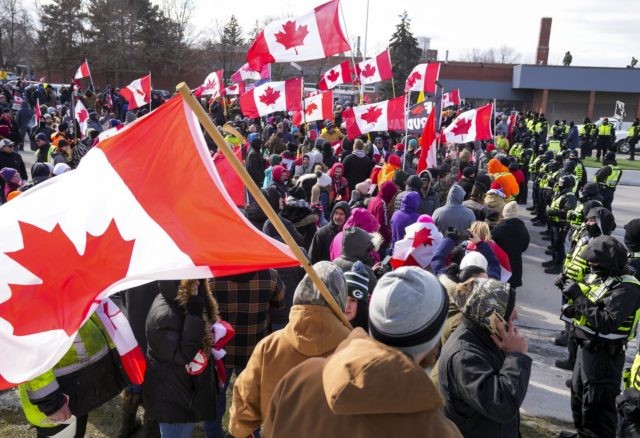WINDSOR, Ontario (AP) — Police moved in to clear and arrest the remaining protesters near a key U.S.-Canadian border bridge early Sunday, trying to end a demonstration against COVID-19 restrictions that has hurt the economy of both nations even as they held back from a crackdown on a larger protest in the capital, Ottawa.
Local and national police formed a joint command center in Ottawa, where protests have paralyzed downtown, infuriated residents who are fed up with police inaction and turned up pressure on Prime Minister Justin Trudeau.
The protests have reverberated across the country and beyond, similar convoys in France, New Zealand and the Netherlands. The U.S. Department of Homeland Security warned that truck convoys may be in the works in the United States.
Windsor police said arrests were being made and vehicles were being towed just after dawn near the Ambassador Bridge linking Detroit and Windsor, Ontario — the busiest border crossing to the U.S.
Only two pickup trucks and less than a dozen protesters blocked the road to the bridge before police moved in. Afterward, police barricades remained and it was not immediately clear when the bridge might be opened.
Police on Saturday had persuaded demonstrators to move their pickup trucks and others cars that they used at the entrance to the crossing that sees 25% of all trade between the two countries, though it remained closed.
In Ottawa, the ranks of protesters swelled to what police said were 4,000 demonstrators on Saturday. The city has seen similar expansions on past weekends, and loud music played as people milled about downtown where anti-vaccine demonstrators have been encamped since late January.
“The whole city is furious at being abandoned by the people who are supposed to protect us. They have completely abandoned the rule of law. @OttawaPolice have lost credibility. #OttawaPoliceFailed,” tweeted Artur Wilczynski, a senior government national security official at Canada’s Communications Security Establishment.
A former minister in Trudeau’s Cabinet also blasted her former federal colleagues as well as the province and city for not putting an end to the protests.
“Amazingly, this isn’t just Ottawa. It’s the nation’s capital,” Catherine McKenna tweeted. “But no one — not the city, the province or the federal government can seem to get their act together to end this illegal occupation. It’s appalling. … Just get your act together. Now.”
Trudeau has so far rejected calls to use the military, but had said that “all options are on the table” to end the protests that have slowed industries on both sides of the border. Trudeau has called the protesters a “fringe” of Canadian society. Both federal and provincial politicians have said they can’t order police what to do.
Ottawa police said in a statement late Saturday that a joint command center had been established with the Ontario Provincial Police and the Royal Canadian Mounted Police. They said that would beef up enforcement capabilities that had been limited by “safety concerns — arising from aggressive, illegal behavior by many demonstrators — limited police enforcement capabilities.”
Police earlier issued a statement calling the protest an unlawful occupation and saying they were waiting for reinforcements before implementing a plan to end the demonstrations.
Ottawa Mayor Jim Watson declared a state of emergency last week for the capital, where hundreds of trucks remained in front of the Parliament Buildings and demonstrators have set up portable toilets outside the prime minister’s office where Trudeau’s motorcade usually parks.
Even after protesters’ vehicles were removed early Saturday, hundreds more arrived to bolster the crowd and settled into a faceoff with police about two blocks away, waving flags and yelling.
On Friday, a judge ordered an end to the blockade of mostly pickup trucks and cars, and Ontario Premier Doug Ford declared a state of emergency allowing for fines of 100,000 Canadian dollars and up to one year in jail for anyone illegally blocking roads, bridges, walkways and other critical infrastructure.
With the bridge closed, auto plants on both sides have been forced to shut down or reduce production. The standoff came at a time when the industry is already struggling to maintain production in the face of pandemic-induced shortages of computer chips and other supply-chain disruptions.
In Ottawa, 31-year-old Stephanie Ravensbergen said she turned out to support her aunt and uncle who have parked their semi in the streets since the beginning of the protest. She opposes vaccine and mask requirements, and said it’s important for schoolchildren to be able see their friends’ faces and emotions.
“We want the right to choose,” Ravensbergen said. “We want the right to be able to do what everybody else can do.”
On the other side of the country, protesters disrupted operations at another border crossing between Surrey, British Columbia, and Blaine, Washington, but officials said it was not blocked. A border crossings in Alberta remained shut down as well.
While the protesters are decrying vaccine mandates for truckers and other COVID-19 restrictions, many of Canada’s public health measures, such as mask rules and vaccine passports for getting into restaurants and theaters, are already falling away as the omicron surge levels off.
Pandemic restrictions have been far stricter there than in the U.S., but Canadians have largely supported them. The vast majority of Canadians are vaccinated, and the COVID-19 death rate is one-third that of the United States.
____
Householder reported from Windsor, and Gillies from Toronto. Associated Press writer Ted Shaffrey in Ottawa, Ontario, contributed to this report.

COMMENTS
Please let us know if you're having issues with commenting.